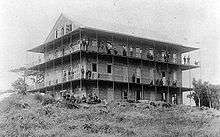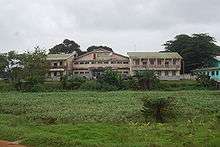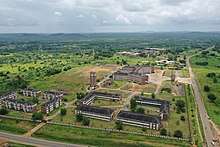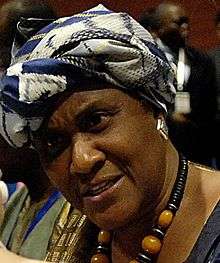University of Liberia
The University of Liberia (UL or LU in older versions of abbreviation) is a publicly funded institution of higher learning located in Monrovia, Liberia. Authorized by the national government in 1851, the University opened in 1862 as Liberia College. UL has four campuses; including the Capitol Hill Campus in Monrovia, Fendell campus in Louisiana, outside Monrovia, the Medical School Campus in Congo Town and the Straz-Sinje Campus located in Sinje Grand Cape Mount County. The University enrolls approximately 18,000 students and is one of the oldest institutions of higher learning in West Africa. It is accredited by the Liberian Commission on Higher Education.
 | |
| Motto | Lux in tenebris (Latin) |
|---|---|
Motto in English | Light in darkness |
| Type | Public |
| Established | 1862 |
| President | Prof. Dr. Julius J. S. Nelson Jr. |
| Provost | Dr. William Ezra Allen |
Academic staff | 331 |
| Students | 18,753 |
| Undergraduates | 26 |
| Postgraduates | 9 |
| Location | , 6°17′57″N 10°47′41″W |
| Campus | Capitol Hill campus Fendell campus Straz-Sinje A.M Doglioti |
| Colors | Red, White, Blue |
| Affiliations | National Commission on Higher Education Association of African Universities |
| Website | www |
History
In 1847, Liberia declared its independence from the American Colonization Society. In 1851 the new national legislature authorized the creation of a state college and chartered Liberia College.[1] Financing was provided by the New York Colonization Society and the Trustees of Donations for Education in Liberia, both United States organizations.[1] These two groups provided almost all of the funds for the school during the 19th century and were responsible for hiring the faculty.[1]
_Liberia_College_in_Monrovia.jpg)
After authorization, groups from Clay Ashland and Monrovia maneuvered in political circles in an attempt to have the school in their cities, with the location eventually chosen as the capital city.[1] This political battle delayed the foundation; on 25 January 1858, the cornerstone of the first building was laid in Monrovia.[2] In January 1862 the school was inaugurated, with classes beginning in 1863.[1] The nation's first president, Joseph Jenkins Roberts, became the school's first president in 1862 and served in that post until 1876.[1]

Seven men made up the first class of students, with a college preparatory division adding 18 students to the enrollment two months later.[1] In addition to American financing, colleges and individuals from the United States donated books and even the bricks and lumber used to construct the school's building.[1] At opening, the library had an estimated 4,000 volumes.[1] Once classes opened, the curriculum was the standard courses typical at American colleges with courses such as rhetoric and Latin.[1] Part of the impetus to start the school was a concern that some Liberians were already leaving the nation to study in Great Britain, which American backers thought might lead to a move away from the republican form of government.[3]
During the 19th century, sophomores and freshmen would battle each other in an annual ritual over whether the freshmen were allowed to wear trousers.[4] From 1866 to 1902 the school had 10 graduates with long periods between the granting of degrees.[1] Under the leadership of Edward Wilmot Blyden, school president from 1881 to 1884, women were allowed to enroll in the preparatory department.[1] During the 1800s UL and country suffered from class and caste conflicts, which led to the temporary closure of Liberia College on several occasions in the 1890s.[1] R. B. Richardson was the first alumnus to become the president of the school.[1]
20th century
The School of Forestry at the college was founded in 1942 by Stephen A. Tolbert, who served as dean of that school until 1960.[5] Enrollment increased at the university to approximately 70 students in 1948 and to 100 in 1950.[6] In 1951, president J. Max Bond, Sr. and dean Anna E. Cooper helped to convert the college into the University of Liberia.[7] Also in 1951, the Law School was established and named after former Liberia Supreme Court Chief Justice Louis Arthur Grimes.[8] In 1956, the now university had an enrollment of 259 students.[6]

In 1968, a medical school was added to the university.[9] Due to civil strife in the country, UL has closed on several occasions including in 1979, 1984, and 1990.[10][11] In one incident in 1984, students and the faculty of the University of Liberia protested the arrest of two faculty members by the Liberian government.[6] Liberian President Samuel K. Doe sent the Liberian Army to attack the school on 22 August 1984, leading to several deaths, more than one hundred injured, a three-month closure, and destruction of some of the facilities.[6] It did not grant any degrees from 1989 to 1996 due to the fighting from the First Liberian Civil War.[12] When UL re-opened in 1997 enrollment totaled 6,000 students,[12] though the civil war had damaged facilities at the university and led many of the faculty to leave the country.[12] The last of the strife ended with the conclusion of the Second Liberian Civil War in 2003.
21st century

In 2007, the American Bar Association paid for renovations to the law school.[13] In April of that year the university opened a new 200-computer digital center paid for by a private company.[14] In June 2007, the school's president suspended classes after a faculty strike over back wages owed by the government,[15] with classes re-opened in July.[16] In February 2008, U.S. President George W. Bush visited the campus during a state visit to Liberia.[17]
China funded a US$21.5 million expansion at the Fendall Campus that began in April 2008 and will add more than five buildings.[18] In March 2009, construction began at that campus of the new Angie Brooks International Center for Women's Research, Peace and Security, named in honor of Angie Brooks, who was the first African female president of the United Nations General Assembly as well as the first female associate justice of the Supreme Court of Liberia.[19] Emmet Dennis became the 13th president of the university that month as enrollment topped 18,000.[20] The Harvey S. Firestone Quadrangle Science Building at the main campus was renovated by Firestone Liberia and re-opened in November 2009.[21]
Academics
The university is the oldest degree-granting school in West Africa,[10] and is accredited by Liberia's Commission on Higher Education.[2] Classes are taught in English with the academic year running from September through August.[2] Undergraduate students earn bachelor's degrees after four years of instruction, while the graduate programs offer master's degrees after two years of post-graduate work.[2] Doctorates in medicine are conferred after the completion of a seven-year program.[2]
As of 2019, there were 18,753 students enrolled at the university in all departments, of which 12,278 are male and 6,422 are female.[22] This made the University the largest by enrollment in Liberia.[22] UL had a total of 331 faculty members at that time. The faculty was male dominated with 304 men and 27 women.[22]
The school is divided into six colleges, three graduate programs, and three professional schools.[23] Colleges at the University of Liberia include the Liberia College of Social Sciences and Humanities, the College of Business and Public Administration, the College of General Studies, and the T. J. R. Faulkner College of Science and Technology.[23] Additionally, there is the William V. S. Tubman Teachers College and the William R. Tolbert College of Agriculture and Forestry, both named after former presidents of the nation.

Louis Arthur Grimes School of Law, the only law school in Liberia, was added into the university in 1951.[24] The A. M. Dogliotti College of Medicine was opened in a partnership between Italy's A. M. Dogliotti Foundation and the government of Liberia.[25][26][27] Students of the medical school are required to give one year of service in rural areas after graduation.[6] The School of Pharmacy is the third professional school, while graduate programs include the Ibrahim B. Babangida Graduate Program in International Relations, the Graduate Program in Regional Science, and the Graduate Program in Education Administration.
In addition to the schools and departments of study, UL houses five institutes.[2] These are the Institute for Research, Institute for Population Studies, Kofi A. Annan Center for Conflict Transformation, Center for Millennium Development Goals, and the Confucius Institute.[2][28] The Confucius Institute teaches the Chinese language and culture and it is also in cooperation with the Changsha University of Science and Technology.[28]
UL is a member of the Association of African Universities.[29]
Facilities

The publicly funded university has four campuses.[30] The Capitol Hill Campus in downtown Monrovia, a medical campus, Straz-Sinje in Grand Cape Mount County and the Fendall campus, about 14 miles northeast of Monrovia.[31] The College of Agriculture and Forestry is at the rural Fendell Campus.[32] The university provides several buses to transport students between these campuses. The main campus was originally designed by Dr. J. Max Bond Sr., former president of the University from 1950 -1954.[33]
Notable alumni

Alumni include past and present Liberian politicians and academics. These include Liberia's Vice President Joseph Boakai[34] and former presidents Arthur Barclay and Joseph James Cheeseman.[1] Candidates for the 2005 Presidential Election included UL alums Nathaniel Barnes, Varney Sherman, Togba-Nah Tipoteh, and Joseph Woah-Tee.[35] The chairperson, Jerome Verdier,[36] and the vice-chair, Dede Dolopei,[37] of the Truth and Reconciliation Commission are alumni. Other alumni are attorney Francis Y.S. Garlawolu, Chief Justice Johnnie Lewis, politician Charles Brumskine, Foreign Minister Olubanke King Akerele, and former United States Ambassador to Liberia and founder of the Maryland Industrial and Agricultural Institute for Colored Youths, Ernest Lyon among others.
Former Presidents
- Dr. J. Max Bond Sr, (1950–1954)
- Dr. Kermit C. King, (1954-1958)
- Dr. Rocherforte L. Weeks, (1957-1972)
- Dr. Advertus A. Hoff, (1972-1975)
- Dr. J Bernard Blamo, (1975–1978)
- Dr. Mary Antoinette Brown-Sherman, (1978-1984)
- Dr. Joseph G. Morris, (1984–1987)
- Dr. Stephen M. Yekeson, (1988–1990)
- Dr. Patrick L. N. Seyon, (1991–1996)
- Dr. Frederick S. Gbegbe, (1996–1999)
- Dr. Ben A. Roberts, (1999–2003)
- Dr. James N. Kollie Sr, Acting (2004)
- Dr. Al-Hassan Conteh, (2004–2008)
- Prof. D. Ansu Sonii Sr, Acting (2008)
- Dr. Emmett A. Dennis (2008-2017)
References
- Livingston, Thomas W. "The Exportation of American Higher Education to West Africa: Liberia College, 1850–1900". The Journal of Negro Education, Vol. 45, No. 3 (Summer, 1976), pp. 246–262.
- About The University of Liberia. Archived 7 September 2008 at the Wayback Machine University of Liberia. Retrieved on 3 September 2008.
- Lulat, Y. G-M. (2005). A History of African Higher Education from Antiquity to the Present: a Critical Synthesis. Greenwood Publishing Group. pp. 277–278. ISBN 0-313-32061-6.
- "Trouble in Liberia", The New York Times, 26 May 1884, p. 4.
- "Stephen A. Tolbert". Facts on File World News Digest. 24 May 1975. pp. Miscellaneous, Obituaries, p. 368 F3.
- Sherman, Mary Antoinette Brown. "The University in Modern Africa: Toward the Twenty-First Century", The Journal of Higher Education, Vol. 61, No. 4 (Jul. – Aug., 1990), pp. 363–385, Ohio State University Press.
- "Liberia; Cuttington University Explains $357US,000 Subsidy". Africa News. 7 July 2008.
- Recent Developments in African Law Faculties. Journal of African Law, Vol. 10, No. 3 (Autumn, 1966), pp. 192–207, p. 198; School of Oriental and African Studies.
- "Monrovia." Encyclopædia Britannica. 2008. Encyclopædia Britannica Online. Retrieved on 31 August 2008.
- Seyon, Patrick L. N. (Summer 1997). "Rebuilding the University of Liberia in the Midst of War". International Higher Education. The Center for International Higher Education. Archived from the original on 15 September 2008. Retrieved 30 August 2008.
- Patrick N. Seyon. Review: Historical Dictionary of Liberia by D. Elwood Dunn; Amos J. Beyan; Carl Patrick Burrowes. The International Journal of African Historical Studies, Vol. 35, No. 1, Special Issue: Leisure in African History (2002), pp. 205–207.
- Oyo, Remi. "Liberia-Education: University plans for the future", IPS-Inter Press Service, 4 December 1997.
- "Renovation of University of Liberia Arthur Grimes Law School". Promoting the Rule of Law. American Bar Association. 6 March 2007. Retrieved 30 August 2008.
- "Digital Bridge Project Launched at the University of Liberia Campus". CIPACO. April 2007. Retrieved 30 August 2008.
- The Inquirer. "Liberia; Classes Suspended at University", Africa News, 20 June 2007.
- The Inquirer. "Liberia; Classes to Resume At UL On Monday", Africa News, 19 July 2007.
- Bush Pledges 1 Million Schoolbooks for Liberian Children. Archived 12 September 2008 at the Wayback Machine America.gov, 21 February 2008. Retrieved on 3 September 2008.
- Liberia Government (10 June 2008). "Liberia; President Sirleaf Launches China-Aided Project of School Buildings At the University of Liberia". Africa News.
- Liberia Government (8 March 2009). "Liberia; Angie Brooks International Center Launched". Africa News.
- Liberia Government (23 March 2009). "Liberia; Visitor of the University of Liberia, President Sirleaf Speaks of Challenges Facing the University". Africa News.
- Zota, Jr., Sam. "We're open for business, but…". The Monitor. Equal Chance Communication Ltd. Archived from the original on 22 July 2011. Retrieved 9 March 2010.
- Kwanue, C.Y. (7 February 2010). "Faculty at Liberia's 9 Universities, Colleges Numbers 1,137". Daily Observer. Retrieved 27 June 2011.
- "Academic Programs". The University of Liberia. Archived from the original on 31 March 2009. Retrieved 14 April 2009.
- Jallah, David A. B. "Notes, Presented by Professor and Dean of the Louis Arthur Grimes School of Law, University of Liberia, David A. B. Jallah to the International Association of Law Schools Conference Learning From Each Other: Enriching the Law School Curriculum in an Interrelated World Held at Soochow University Kenneth Wang School of Law, Suzhou, China, October 17–19, 2007." International Association of Law Schools. Retrieved on 1 September 2008.
- "Monrovia." Encyclopædia Britannica. 2008. Encyclopædia Britannica Online. Retrieved on 31 August 2008.
- "Liberia; Firestone Hailed for Help to Cuttington". Africa News. 26 May 2008.
- Liberia Government (19 March 2009). "Liberia; A.M. Doglioti Medical Colledge At 40 – President Sirleaf Recommits Government Support". Africa News.
- "UL launches Confucius Institute tomorrow". The Inquirer. 18 December 2008.
- "Member Details: University of Liberia". Membership. Association of African Universities. Archived from the original on 27 September 2011. Retrieved 29 June 2011.
- The Inquirer. "Liberia; ULSU Wants Budget Stopped", Africa News, 11 July 2007.
- "China to fund Liberian school project". BBC Monitoring Africa. BBC Worldwide Monitoring. 11 June 2008.
- The Inquirer. "Liberia; Firestone Donates to Camp-Based Group", Africa News, 1 December 2006.
- Pace, Eric (18 December 1991). "J. Max Bond Sr., 89, an American Who Headed Liberian University". The New York Times. Retrieved 14 April 2009.
- "Biography of Vice President Joseph N. Boakai". The Executive Mansion. The Republic of Liberia. Archived from the original on 24 June 2008. Retrieved 15 April 2009.
- "Candidates for President in Election 2005". TLC Africa. Retrieved 2 September 2008.
- "Cllr. Jerome J Verdier, Sr, Chairman". Meet the Commissioners. The Truth and Reconciliation Commission of Liberia. Archived from the original on 29 April 2009. Retrieved 15 April 2009.
- "Dede Dolopei, Vice Chairperson". Meet the Commissioners. The Truth and Reconciliation Commission of Liberia. Archived from the original on 29 April 2009. Retrieved 15 April 2009.
External links
| Wikimedia Commons has media related to University of Liberia. |